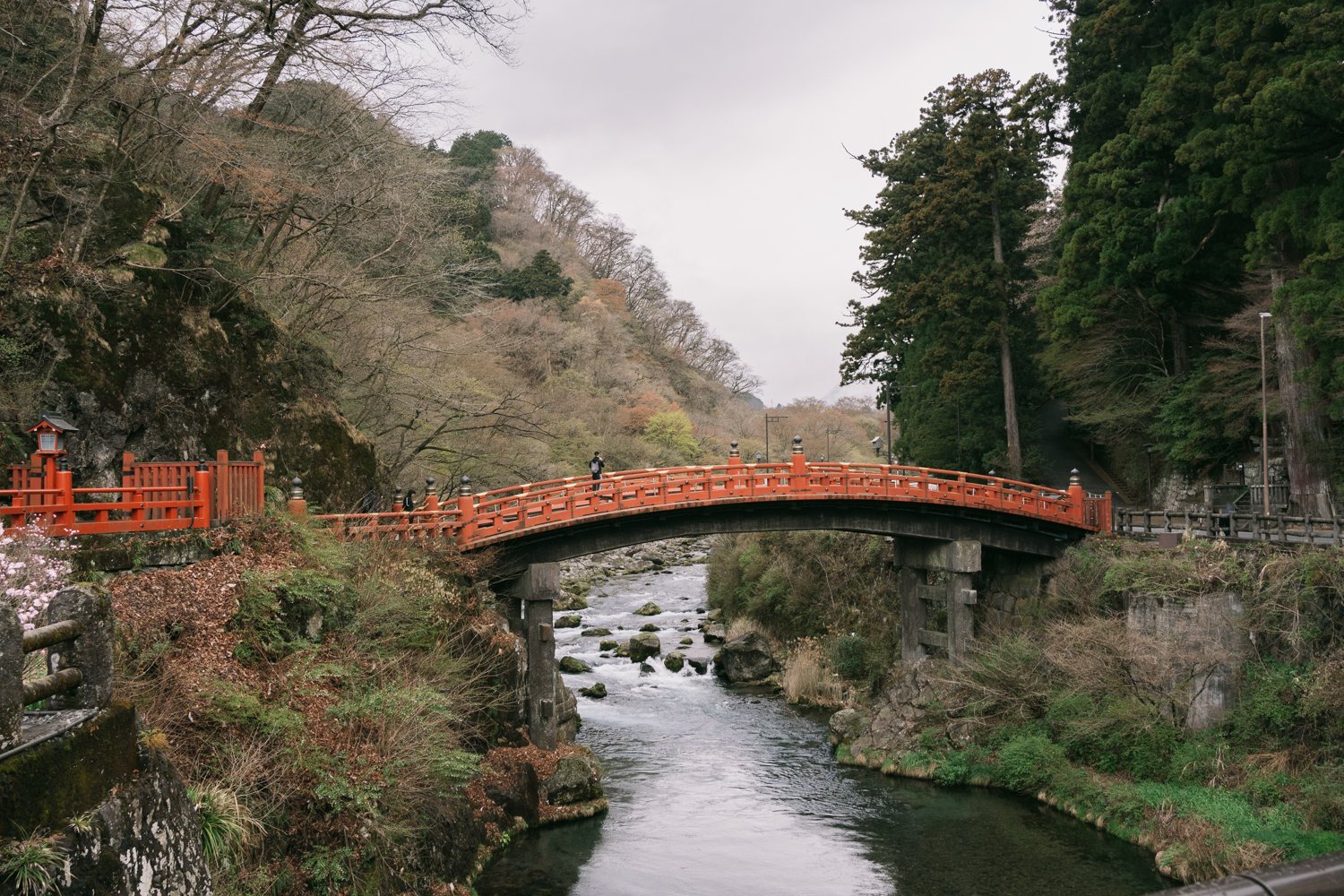24 Hours in Nikko
by Jonny Gleason
A Quick Escape to Serenity
Jonny Gleason is a London-based travel writer and photographer. When not traveling, you can catch him with a good book (or two).
Having lived next to Tokyo for an entire year of my life, it’s safe to say I’m still in love with the city. The BIC camera and Don Quijote soundtracks sprinkled throughout my daily walks, the super niche hobby shops, and the endlessly dressed-up animals - there’s never a dull moment. But after an intense few days of exploring and daily record-breaking step counts, I’m left looking for somewhere to escape to, if only briefly.
With its backdrop of Shinto temples, towering mountains, and surging rivers, Nikko has a lot to offer the intrepid traveller. Here’s how I recently spent 24 hours there.
The first time I came to Nikko, I hopped on a train from Asakusa to Minami-Kurihashi and took the Tobu-Nikko line to Shiimo-Imachi station. The second part took me through forests abundant with bamboo, rice fields ready for harvesting, and suburban villages rarely visited by outsiders. It’s not a fast way to Nikko by any means, but a single carriage train trundling across the Japanese countryside is my kind of mindful travelling.
If that’s not your idea of a fun way to spend a few hours, use the direct Tobu Railway Express, which operates daily. If you’re looking for something a little more luxurious, the new Spacia X should satisfy your tastes if you can get tickets.
From there, I hopped on a local train to Kinugawa Onsen Station and was greeted by a rare sighting of the SL Taiju steam train on the turntable out the front. There was also some free space at the public Kinutanoyu (foot spa), which I quickly made use of.
Kinugawa River Cruise
5 minutes of walking through backstreets and you’ll find Kinugawa Line Outbound - our first stop of the day. Japan is a country very much in touch with its past, and floating down the Kinugawa River in a traditional tatami floored boat is something very few will ever experience.
Once part of a crucial trade route for Tohoku clans, it is now open for visitors looking for a one-of-a-kind experience on their trip to Nikko. While you won’t be transporting tobacco, lacquerware, rice, or safflower, you’ll still experience the same rapids and similar views that merchants did over 400 years previously.
I couldn’t understand much of the Japanese information along the way, but the high spirits and friendly attitude of the captain made it a non-issue. As we floated downriver, I noticed several lone fishermen attempting to catch their next meal - none successful in the short time we passed, though each seemed content with simply being.
A 40-minute ride on a traditional Kinugawan riverboat flanked by thousands of trees and the peaceful sound of flowing water is, perhaps, one of the most enjoyable ways to reconnect with travel and ground yourself in the present moment. Visit in Autumn, and you’ll be treated to a spectacular viewing of Kōyō, the changing of the leaves, which is made all the more impressive as they rise hundreds of metres above you.
After arriving downstream, I quickly devoured two sticks of freshly cooked miso dango and jumped on the shuttle bus back to the station. With my stomach momentarily satisfied, I hopped on the train and made my way to Tōbu-Nikkō station.
Café Stop
20 minutes by foot or 5 minutes by reliable local bus took me to our café stop for the day - a necessity of any day trip in Japan. There are plenty to choose from along the way, but meguri coffee is the easiest recommendation of all. It should be more popular than it is, but for some reason, it’s a café people haven't found yet.
Photo courtesy of thejapaneserose.com
As you open the doors to what was once an old antique shop, you’ll find a light and airy café ready to welcome weary travellers from the road. High beamed ceilings and tatami-covered floors throughout create a surprisingly cosy experience, while floor-to-ceiling windows pay an ode to the Nikko’s stunning natural landscape.
For food, you’ll find a mix of Asian, vegan, and macrobiotic offerings in a daily teishoku style. Having tried hundreds of coffees across Japan, their hand-roasted Fairtrade beans are subjectively brilliant, and the care taken with each cup is plain to see. I chose to sit cross-legged in the window while watching the world pass by, though a few chairs and tables were also available.
Toshogu Temple Complex
After finishing up at meguri coffee, I headed to the Toshogu Temple complex. It’s just a couple of minutes away and the obvious place to explore after refuelling.
Before I make it to the stairs, the vermillion red Shinkyō Bridge on the corner catches my eye with the rushing waters of the Daiya River matching the passing cars in volume. Its storied past acting as the physical entrance to Nikko’s temples makes it an iconic and sacred landmark of the area. There’s little denying its position as one of Japan’s three finest bridges, though while you can pay to walk along it, a simple look and moment’s contemplation is likely enough for most.
Upon entering its grounds, the hum of distant traffic and the bustle of Nikko town reduces to near silence. On this particular day, the mist-like rain fell relentlessly, yet the birds still chirped, and the canopy of ancient trees sheltered us from the worst of it. Up there among the trees, the world feels like it moves a lot slower, so take your time and enjoy it.
Remnants of a time past can be found around every corner including Sanzaru's three monkeys, Hidari Jingorō’s Nemuri-neko (sleeping cat) carvings, the Gojū-no-tō five-story pagoda, and the ornately decorated Yomeinom Gate with bright colours and gold leaf. The path to Honjido Hall is also one of my favourite parts and can be explored without paying extra.
Evening Meal
After an hour or two of walking around the temple grounds, the familiar call for food returned. A short stroll back down to the valley will take you to Cafe Restaurant BELL, a quaint food stop you’d never know existed unless you’ve been told. If you’re looking for an authentic Japanese experience which you won’t find in the guidebooks, this is the place to come. The traditional Yuba (famous in Nikko) Monk’s Set seemed like the obvious choice after visiting those ancient temples, and being served straight from an obasan's kitchen is the kind of experience everyone deserves to have at least once. Unlike station platform ramen, the service is unhurried, and it doesn't take itself too seriously. Luckily we’re in no rush, and it gives us plenty of time to appreciate the eclectic surroundings.
The Accommodation
A ryokan called Nikko Hoshinoyado is where I chose to lay my head for the night - within touching distance of the Shinkyō bridge and right in the centre of town. The rooms are the epitome of Japanese minimalism, and the Omotenashi (Japanese hospitality) is as exemplary as you’d expect. With futons prepared for you while you bathe in the onsite onsen, it’s the perfect place to reset your mind and a wallet-friendly treat for most travellers.
If you’re looking for something a little more luxurious, Fufu Nikko is just up the road and well worth the extra yen. In any case, if you’re looking for an authentic and traditional stay, choose a ryokan.
*Note that Wondertrunk has a working relationship with Fufu Nikko and regularly sends clients to their beautiful and peaceful property.
Kanmangafuchi Abyss
After spending the morning enjoying the traditional kaiseki breakfast, it was time for a mini adventure before heading back to the capital. Created by an eruption from Mt. Natai about 7,000 years ago, Kanmangafuchi abyss is a gorge and river just moments away from the heart of Nikko.
As I walked along the riverside path, I passed by the 70 jizo statues - legend says the amount changes every time you visit. They are said to protect children, women, and travellers on their journey onwards. Most are in varying states of decay and many with offerings of yen piled high and red caps and bibs worn to ward off danger and illnesses.
A thirty to forty-five-minute walk around countryside trails and backstreets with Ojisan’s tending to hatake, lush green moss carpeting the forest floor, riverside sections, and local history - a peaceful way to round off our time in Nikko.
Interested in visiting Nikko? Get in touch with our team of expert consultants today to learn more about this stunning mountainous area and how to plan the perfect visit.










